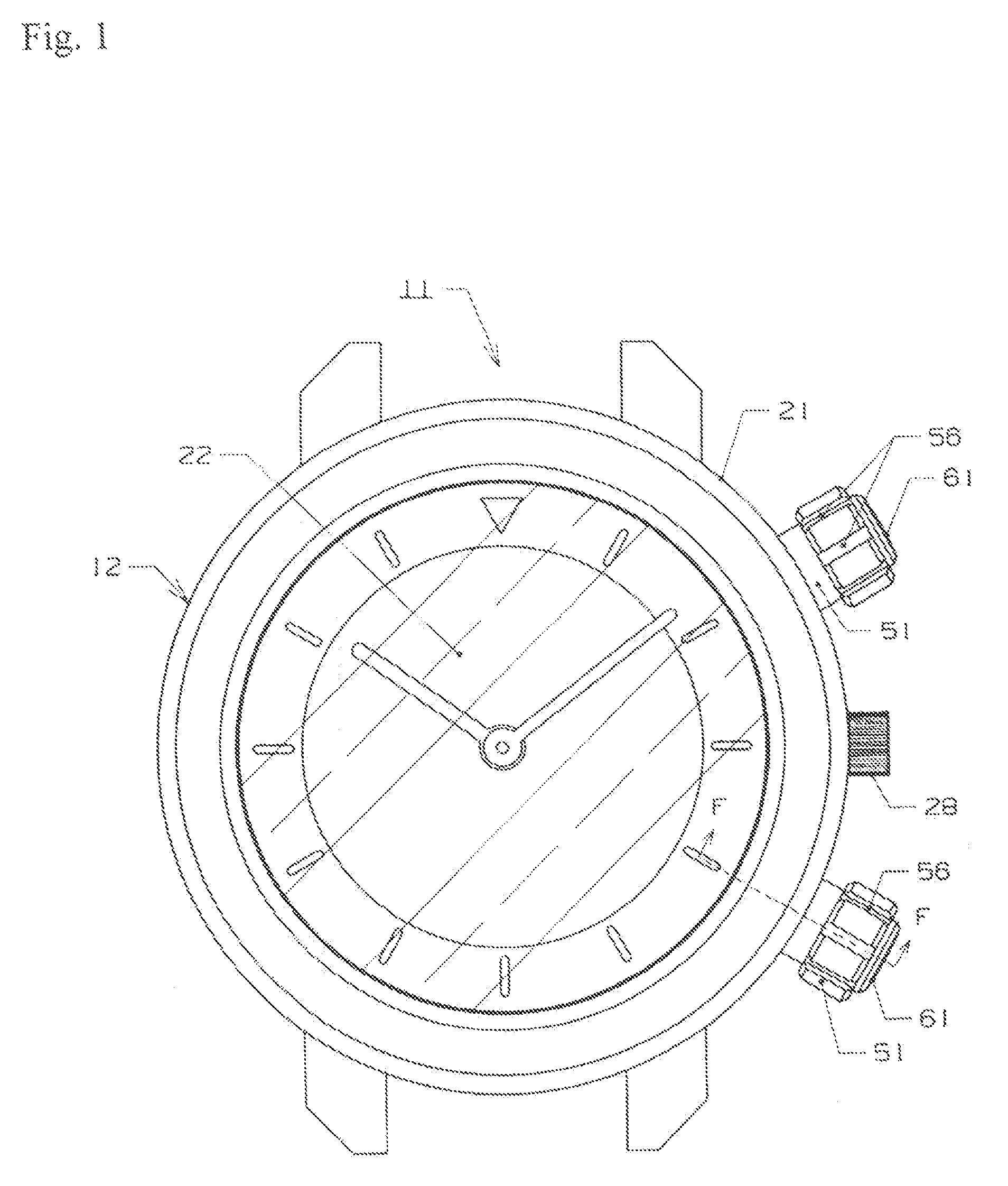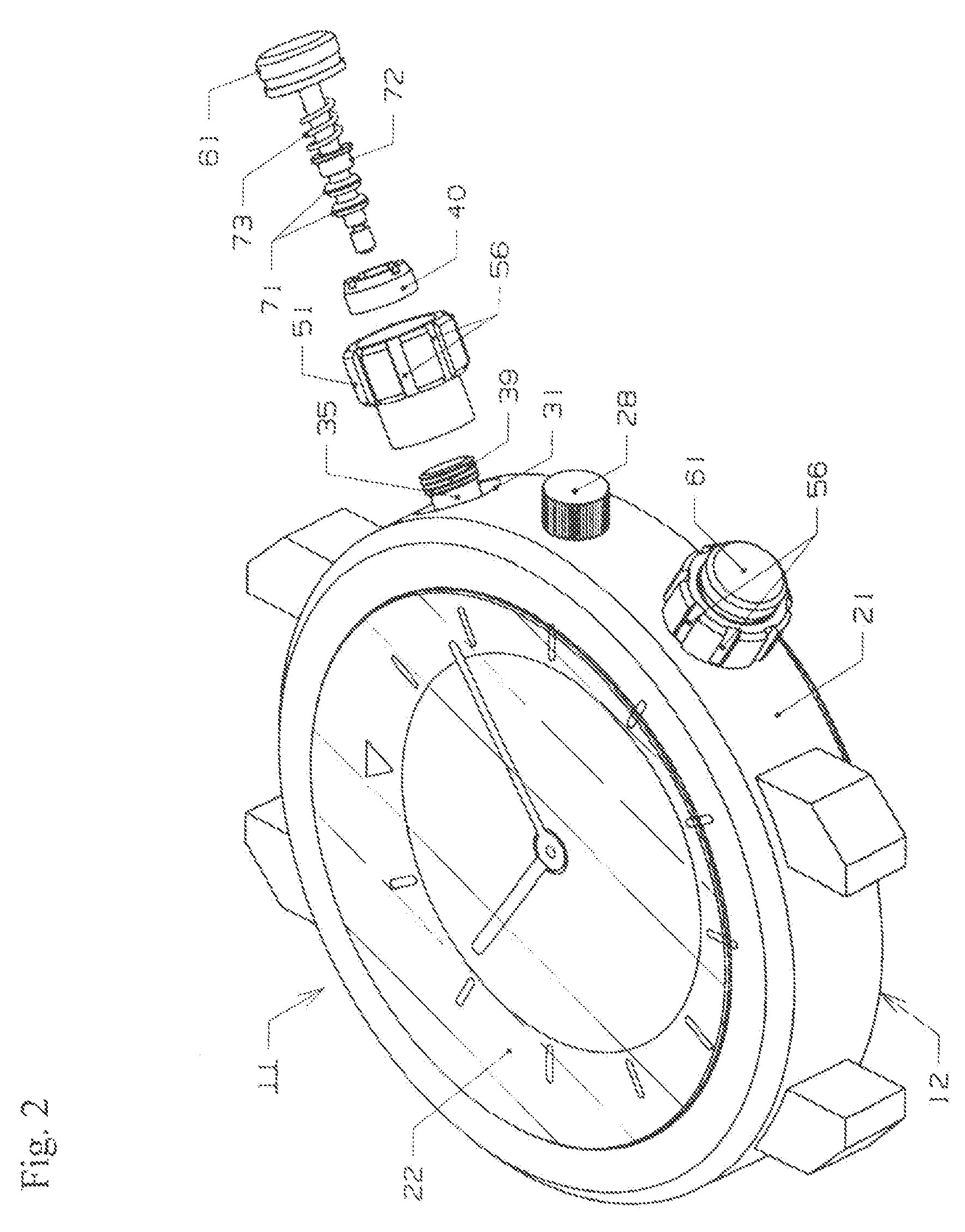Portable apparatus and portable timepiece
a technology of portable equipment and timepiece, which is applied in the direction of electric winding, instruments, and horology, can solve the problems of excessive rotation of locking parts, parts or rotary rings, and the inability to prevent the ingress of debris into the female and male threaded parts,
- Summary
- Abstract
- Description
- Claims
- Application Information
AI Technical Summary
Benefits of technology
Problems solved by technology
Method used
Image
Examples
first embodiment
[0051]the present invention is explained in conjunction with FIG. 1 to FIG. 4.
[0052]In FIG. 1 to FIG. 4, symbol 11 indicates a potable apparatus such as a portable timepiece, to be more specific, a wrist watch which is used as a waterproof timepiece. The timepiece 11 includes an apparatus exterior body, for example, a timepiece exterior body 12.
[0053]As shown in FIG. 3 and FIG. 4, in the inside of the timepiece exterior body 12, predetermined members are housed. The predetermined members include: a display board such as a dial 13, for example; an apparatus which controls a display such as a movement 14 which controls the movement of time indicating pointers, for example; a lamp not shown in the drawing; and a battery not shown in the drawing which is provided as a power source.
[0054]The movement 14 includes at least one, for example, two button response members, for example, contacts 15 (only one contact shown in FIG. 2 and FIG. 4). Each contact 15 is formed of a leaf spring or the ...
third embodiment
[0113]In the third embodiment, a locking portion 55 of a locking member 51 is formed such that the locking portion 55 partitions a bottom of an intermediate recessed portion 54 and occupies an area ranging from the partitioned portion of the bottom of the intermediate recessed portion 54 to a distal end surface of a small-diameter portion 51a. An inner diameter of the locking portion 55 is smaller than an inner diameter of the intermediate recessed portion 54. A side surface 55a of the locking portion 55 also functions as a bottom surface of the intermediate recessed portion 54.
[0114]The side surface 55a is used as an engaging surface which is brought into contact with and is separated from the stopper portion 40. Further, a female threaded portion 52 is formed on the inner periphery of the locking portion 55. The locking member 51 is mounted on the pipe 35 by threadedly engaging the female threaded portion 52 thereof with a male threaded portion 38 formed on a pipe 35. The third em...
fourth embodiment
[0117]In the fourth embodiment, a stopper portion 40 is integrally formed on the outer periphery of a small-diameter portion 37b of an externally arranged sleeve portion 37 of a pipe 35. An outer diameter of the stopper portion 40 is set larger than an outer diameter of a male threaded portion 38.
[0118]Further, in the fourth embodiment, the locking member 51 is formed of two members, that is, a first member element 51c and a second member element 51d.
[0119]That is, the first member element 51c has a ring shape. A female threaded portion 52 which is threadedly engaged with a male threaded portion 38 of a pipe 35 is formed on the inner periphery of the first member element 51c, and a locking portion 55 is formed on the first member element 51c at a position displaced from the female threaded portion 52. An inner diameter of the locking portion 55 is slightly larger than an outer diameter of the male threaded portion 38 formed on the pipe 35. A male threaded portion 51f is formed on t...
PUM
 Login to View More
Login to View More Abstract
Description
Claims
Application Information
 Login to View More
Login to View More - R&D
- Intellectual Property
- Life Sciences
- Materials
- Tech Scout
- Unparalleled Data Quality
- Higher Quality Content
- 60% Fewer Hallucinations
Browse by: Latest US Patents, China's latest patents, Technical Efficacy Thesaurus, Application Domain, Technology Topic, Popular Technical Reports.
© 2025 PatSnap. All rights reserved.Legal|Privacy policy|Modern Slavery Act Transparency Statement|Sitemap|About US| Contact US: help@patsnap.com



